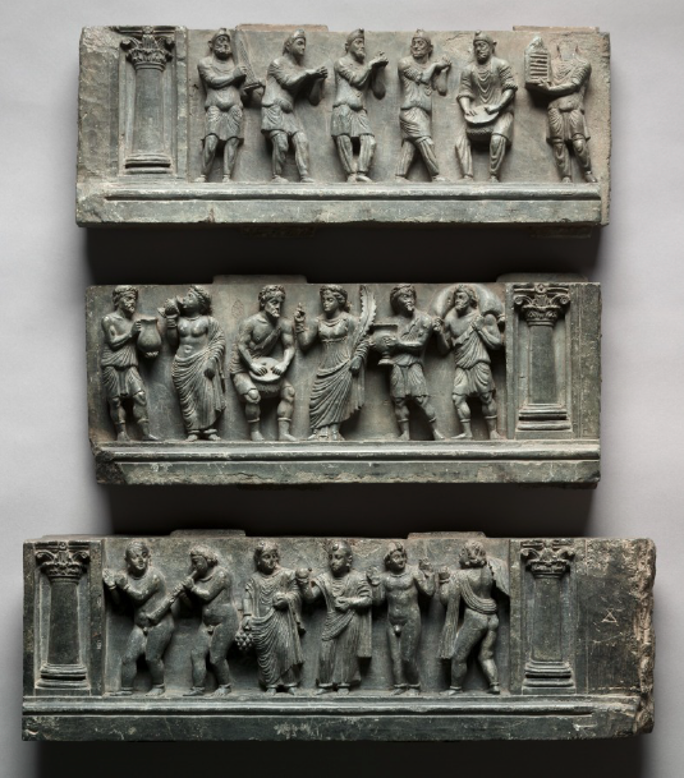Peopling the Past is a Digital Humanities initiative that hosts free, open-access resources for teaching and learning about real people in the ancient world and the people who study them. Recently featured in the Peopling the Past blog was Art History PhD Candidate, Prabhjeet Johal, discussing her work on wine production and consumption in Parthia and Gandhara (modern Iran and NW Pakistan), which moves away from a hellenocentric view to a more localized, inter-regional approach. Prabhjeet's work focuses on cultural interaction in art history, especially Dionysus in the East and wine production and consumption scenes. She has taken part in excavations in Greece, Macedonia, and Italy.
You can read the full blog post featuring Prabhjeet below and on the Peopling the Past website.
Blog Post #15: Grad Student Feature with Prabhjeet Johal
One of Peopling the Past’s goals is to amplify the work of young and/or under-represented scholars and the amazing research that they are doing to add new perspectives to the fields of ancient history and archaeology (broadly construed). We will thus feature several blog posts throughout the year interviewing graduate students on their research topics, focusing on how they shed light on real people in the past.
What topic do you study?
My name is Prabhjeet Johal, and I am PhD Candidate in the department of Art History at the University of Toronto. My dissertation project focuses on wine production and consumption from the second-century BCE to the second-century CE in Parthia and Gandhara – or, what is today modern-day Iran to north-west Pakistan. My aim is to critically evaluate Classical art history and archaeology (carried out/as practiced in the 19th and 20th centuries) by returning to a material-first approach through the study of figural scenes, archaeological sites and drinking and manufacturing implements in order to gain a localized perspective of wine culture along the routes that were precursors to the Silk Road.
What sources or data do you use?
Our largest source of information on wine culture in this area are sculptural reliefs that are found in various contexts and styles. Generally, these scenes of wine production and consumption are often accompanied by vine leaves and tendrils, grape clusters, musicians, dancers, and putti-like figures. These features, known also from ancient Greece and Rome, have consequently led to such scenes being used as “proof” to assert the dominance of Classical art and culture. In order to decolonize this material and to reconceptualize this area in less Eurocentric terms, a reassessment of these reliefs and material culture is vital.

These sculptural reliefs are spread across various museums in the UK, Germany, and France, all of which are countries that led archaeological expeditions to Iran, Afghanistan, Tajikistan, and Pakistan. A holistic study of all these artefacts has never been carried out. An important part of my methodology involves travel to, and collation of, these finds, in addition to studying the archival documents relating to their excavation. The latter is especially important as much of the material culture is without context or was poorly documented due to early archaeological practices and ongoing political strife and illegal looting.
However, original site photos and notes can help make more sense out of potential assemblages, display practices, and even stylistic trends. Archaeological reports are also important in determining sites that produce wine and those that were sites of consumption. This information tells us about the relationship between sites and people by helping us answer larger questions of economy, social hierarchy, access to goods, and – in the case of Gandhara – religious involvement.
How does this research shed light on real people in the past?
The discussion of wine-related imagery and culture from these regions has only occurred in the wider context of hellenocentric scholarship and seldom in its own right as a topic of inquiry. Scholarship has been hung up on the interaction between classical and non-classical cultures in the Hellenistic east and, as a result, we lack a complex understanding of inter-regional interaction, even though we have the material culture and sources to carry out such a project.
Focusing on the sites along what is considered the precursor to the Silk Road we can instead gain insight into the local viticultural practices that preceded Greek presence and followed the demise of these Hellenistic kingdoms. A full re-assessment of the evidence that we have in comparison to the recently excavated materials from Gandhara offers us a chance to understand what the relationships among sites, institutions, and individuals were and the role that wine played in fostering this cross-cultural interaction.
An example of these relationships is the occurrence of wine distillation implements in the Buddhist religious monastic sites of Gandhara. This complicates our understanding of the role that early Buddhism played in the area. Why would Buddhist monks be distilling wine when it is forbidden to them? Furthermore, a number of figural scenes that adorn Buddhist stupas in Gandhara show Parthians, Scythians, Greeks and Gandharans drinking, dancing, and producing wine. Does this imagery reflect local diversity and was wine a connecting social, cultural, political, and religious endeavor? A closer look at the material evidence implores us to move beyond the hellenocentric perspective of Greek dominance and instead understand the local and regional complexities in their own right, and reveals the voices and agency of the people that lived in this area.

Photo credit: Mishko Tutkovski
Prabhjeet Johal is a Joseph Armand Bombardier funded PhD candidate in Art History at the University of Toronto and has a Mst in Classical Archaeology from the University of Oxford and a BA in Archaeology and History of Greece, Rome, and the Near East from the University of British Columbia. Prabhjeet focuses on Hellenistic art and in particular, on Greeks in the East. She is interested in issues of cross-cultural interaction as a theoretical framework in art historical practice as well as its historiographic application to the study of the Hellenistic and Roman periods as addressed in both post-colonial theory as well as in colonial art history and archaeology. Prabhjeet is also interested in the reception of Greek art in Rome and the formation of elite Roman epistemological systems surrounding the display and experience of art. She has also previously taken part in archaeological excavations and conservation work at the sites of Despotiko in Greece, Stobi in Macedonia, and Populonia in Italy. Her current research is on Dionysus in the East as well as wine production and consumption scenes from Ecbatana to Taxila.


